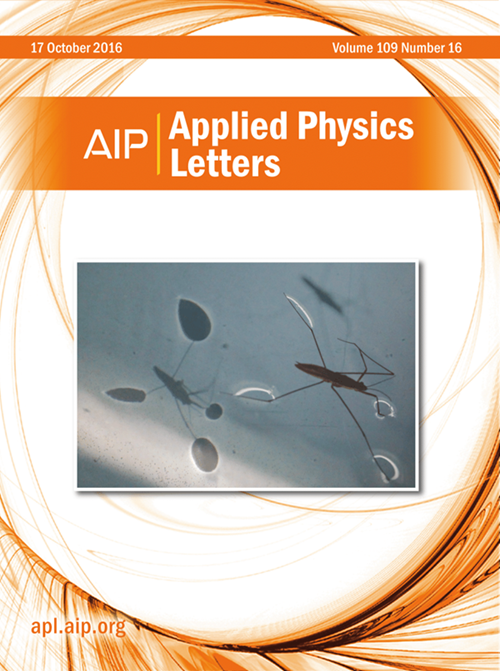CoSe2 nanoparticles catalyzed the formation of Cu-BTC polyhedral nanoframes enabling biosensing of endogenous opioid peptides
IF 3.5
2区 物理与天体物理
Q2 PHYSICS, APPLIED
引用次数: 0
Abstract
We describe a point-of-care biosensing platform for the detection of endogenous opioids using an integrated assay. In this system, cobalt–selenium (Co-Se2) nanoparticles catalyze the formation of tunable Cu-BTC metal–organic framework (MOF) nanostructures (Cu-BTC@Co-Sex:1MOFs), which serve as potential biosensing candidates. These Cu-BTC@Co-Sex:1MOFs are functionalized with mono-target (Anti-Met-Enk or Anti-Leu-Enk) and/or dual-target (Anti-Met-Enk/Leu-Enk) antibodies for the selective and simultaneous recognition of Met-Enkephalin (Met-Enk) and Leu-Enkephalin (Leu-Enk). Bovine serum albumin is employed as a blocking agent to minimize nonspecific binding, thereby enhancing the specificity and reproducibility of the biosensor and enabling the detection of Met-Enk and Leu-Enk within clinically relevant concentration ranges. Among various MOF configurations, the Cu-BTC@Co-Se3:1MOFs-based biosensing platform exhibits a broad detection range, 1.0–200.0 pg/mL for Met-Enk and 5.0–300.0 pg/mL for Leu-Enk covering physiological concentration ranges, with limits of detection of 0.81 and 3.64 pg/mL, respectively (S/N = 3). These performance characteristics are primarily attributed to the following: (i) a noticeable difference in isoelectric points between Cu-BTC@Co-Se3:1MOFs (≥8.61) and Anti-Met-Enk-Abs (∼4.94), which facilitates electrostatic interactions for effective antibody incorporation; (ii) the distribution of Co-Se2 nanoparticles within the MOF porous cavities and on the surface, providing a high active surface area (57.4 and 51.6 m2/g), which enables the efficient Anti-Met-Enk-Abs antibody immobilization; and (iii) ester-like bridging between antibody carboxyl groups and metal centers (Cu, Co, and Se) through chemical adsorption interactions. Finally, clinical validation with human serum and artificial mouse cerebrospinal fluid showed recovery rates of 90.6%–96.2%, comparable to those from a standard ELISA kit.CoSe2纳米颗粒催化形成Cu-BTC多面体纳米框架,实现内源性阿片肽的生物传感
我们描述了一个点护理生物传感平台检测内源性阿片类药物使用综合分析。在该体系中,钴硒(Co-Se2)纳米颗粒催化形成可调谐的Cu-BTC金属有机框架(MOF)纳米结构(Cu-BTC@Co-Sex: 1mof),作为潜在的生物传感候选者。这些Cu-BTC@Co-Sex: 1mof被单靶点(Anti-Met-Enk或Anti-Leu-Enk)和/或双靶点(Anti-Met-Enk/Leu-Enk)抗体功能化,用于选择性和同时识别Met-Enk和Leu-Enk。牛血清白蛋白被用作阻断剂,以减少非特异性结合,从而提高生物传感器的特异性和可重复性,并使Met-Enk和Leu-Enk在临床相关的浓度范围内检测。在多种MOF配置中,基于Cu-BTC@Co-Se3: 1mofs的生物传感平台检测范围广,Met-Enk检测范围为1.0-200.0 pg/mL, Leu-Enk检测范围为5.0-300.0 pg/mL,覆盖生理浓度范围,检测限分别为0.81和3.64 pg/mL (S/N = 3)。这些性能特征主要归因于以下原因:(i) Cu-BTC@Co-Se3:1MOFs(≥8.61)和Anti-Met-Enk-Abs(~ 4.94)之间的等电点显著差异,这有利于静电相互作用,从而有效地结合抗体;(ii) Co-Se2纳米颗粒在MOF多孔腔内和表面的分布,提供了高活性表面积(57.4和51.6 m2/g),从而实现了高效的Anti-Met-Enk-Abs抗体固定化;(iii)通过化学吸附作用在抗体羧基和金属中心(Cu、Co和Se)之间建立类似酯的桥接。最后,用人血清和人工小鼠脑脊液进行临床验证,回收率为90.6% ~ 96.2%,与标准ELISA试剂盒的回收率相当。
本文章由计算机程序翻译,如有差异,请以英文原文为准。
求助全文
约1分钟内获得全文
求助全文
来源期刊

Applied Physics Letters
物理-物理:应用
CiteScore
6.40
自引率
10.00%
发文量
1821
审稿时长
1.6 months
期刊介绍:
Applied Physics Letters (APL) features concise, up-to-date reports on significant new findings in applied physics. Emphasizing rapid dissemination of key data and new physical insights, APL offers prompt publication of new experimental and theoretical papers reporting applications of physics phenomena to all branches of science, engineering, and modern technology.
In addition to regular articles, the journal also publishes invited Fast Track, Perspectives, and in-depth Editorials which report on cutting-edge areas in applied physics.
APL Perspectives are forward-looking invited letters which highlight recent developments or discoveries. Emphasis is placed on very recent developments, potentially disruptive technologies, open questions and possible solutions. They also include a mini-roadmap detailing where the community should direct efforts in order for the phenomena to be viable for application and the challenges associated with meeting that performance threshold. Perspectives are characterized by personal viewpoints and opinions of recognized experts in the field.
Fast Track articles are invited original research articles that report results that are particularly novel and important or provide a significant advancement in an emerging field. Because of the urgency and scientific importance of the work, the peer review process is accelerated. If, during the review process, it becomes apparent that the paper does not meet the Fast Track criterion, it is returned to a normal track.
 求助内容:
求助内容: 应助结果提醒方式:
应助结果提醒方式:


